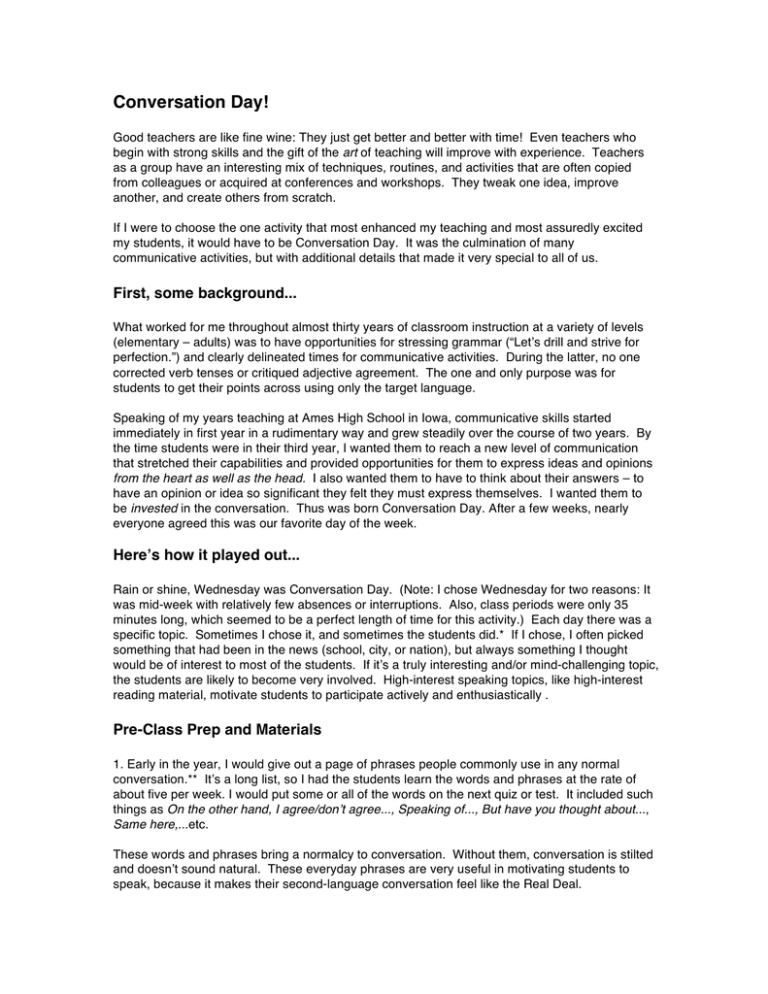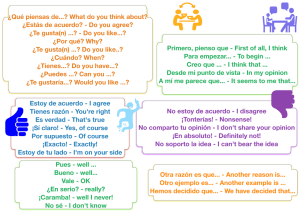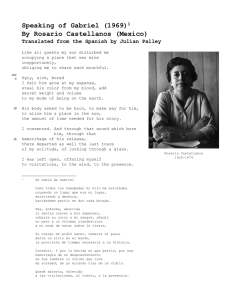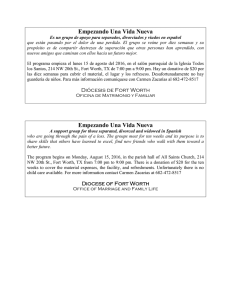Conversation Day!
Anuncio

Conversation Day! Good teachers are like fine wine: They just get better and better with time! Even teachers who begin with strong skills and the gift of the art of teaching will improve with experience. Teachers as a group have an interesting mix of techniques, routines, and activities that are often copied from colleagues or acquired at conferences and workshops. They tweak one idea, improve another, and create others from scratch. If I were to choose the one activity that most enhanced my teaching and most assuredly excited my students, it would have to be Conversation Day. It was the culmination of many communicative activities, but with additional details that made it very special to all of us. First, some background... What worked for me throughout almost thirty years of classroom instruction at a variety of levels (elementary – adults) was to have opportunities for stressing grammar (“Letʼs drill and strive for perfection.”) and clearly delineated times for communicative activities. During the latter, no one corrected verb tenses or critiqued adjective agreement. The one and only purpose was for students to get their points across using only the target language. Speaking of my years teaching at Ames High School in Iowa, communicative skills started immediately in first year in a rudimentary way and grew steadily over the course of two years. By the time students were in their third year, I wanted them to reach a new level of communication that stretched their capabilities and provided opportunities for them to express ideas and opinions from the heart as well as the head. I also wanted them to have to think about their answers – to have an opinion or idea so significant they felt they must express themselves. I wanted them to be invested in the conversation. Thus was born Conversation Day. After a few weeks, nearly everyone agreed this was our favorite day of the week. Hereʼs how it played out... Rain or shine, Wednesday was Conversation Day. (Note: I chose Wednesday for two reasons: It was mid-week with relatively few absences or interruptions. Also, class periods were only 35 minutes long, which seemed to be a perfect length of time for this activity.) Each day there was a specific topic. Sometimes I chose it, and sometimes the students did.* If I chose, I often picked something that had been in the news (school, city, or nation), but always something I thought would be of interest to most of the students. If itʼs a truly interesting and/or mind-challenging topic, the students are likely to become very involved. High-interest speaking topics, like high-interest reading material, motivate students to participate actively and enthusiastically . Pre-Class Prep and Materials 1. Early in the year, I would give out a page of phrases people commonly use in any normal conversation.** Itʼs a long list, so I had the students learn the words and phrases at the rate of about five per week. I would put some or all of the words on the next quiz or test. It included such things as On the other hand, I agree/donʼt agree..., Speaking of..., But have you thought about..., Same here,...etc. These words and phrases bring a normalcy to conversation. Without them, conversation is stilted and doesnʼt sound natural. These everyday phrases are very useful in motivating students to speak, because it makes their second-language conversation feel like the Real Deal. 2. “Cheat Sheets”*** – For each Conversation Day, on a half-sheet of paper, I presented the topic with vocabulary they were likely to want or need (in both Spanish and English) and six to ten suggested questions.*** The students knew they were not required to use any of the questions. I merely provided them to get the conversation started. I didnʼt choose to test students on this vocabulary, though one certainly could. I wanted this day to be completely pleasurable. Fun is highly motivating. Having fun while learning a valuable skill is dynamite! Even without testing and grades involved, students retained a few words each week. Set-Up for Success Iʼm a firm believer that, for general classroom management and for specific routines and activities, every minute spent in “training” students pays back ten-fold. When they know from Day 1 what your expectations are with regard to behavior and attitude, and you insist they follow certain procedures, you save untold time and stress as the year goes on. Preparing well at the beginning of anything new always greatly improves the chances of success. Once October of third year rolled around, we were ready to start. There are important reasons I waited several weeks to initiate Conversation Day. First, I wanted to give the students time to reacclimate themselves to Spanish after a summer of little or no exposure to this wonderful language. Second, I wanted time for us to develop a class cohesion, a camaraderie, and an atmosphere of trust and security. On Tuesday before our first Conversation Day, I explained with great enthusiasm what was going to transpire the next day. I wanted them to have a sense of entering a new phase – something akin to getting their driverʼs license! (Iʼll admit to falling slightly short of that lofty goal, but the students certainly went along with the idea that they were ready for a new – and fun – challenge.) These are the instructions we went over the day before our first Wednesday so as to save time on The Day. + As soon as students entered the room, they were to move the desks to the perimeter of the room. At the end of the hour, unless there was another third-year class coming, everyone was expected to move one or more desks back as necessary, and no one was to leave until the task was finished. + They were to sit in a circle and take out their sheet of Vocabulario general para conversar.* + “Rules of engagement” were the same as they had always been in my classes, but more so. 1. Be respectful at all times. 2. Try not to interrupt, but if you must, do it politely. “Excuse me, but...” 3. Show interest in what your partner is saying to encourage him/her. Your full attention and eye contact are important. 4. Ask more about someone elseʼs ideas and opinions. Follow-­‐up questions and comments are strongly encouraged! Build on what others say. 5. Conversation is like a tennis match. You hit the ball across the net, and then your partner returns it. You both try to volley as long as you can. 6. Stay on the general topic. Tangents are acceptable; they “happen” all the time in real life. However, switching to an account of your date last weekend is not acceptable. 7. Keep the conversation going! No down time! No “Weʼre done!” Once the students have learned the routine, instructions arenʼt necessary every week. Standing at the door to greet them and to announce, ”Itʼs Conversation Day!” is a pleasant and appropriate way to start the day. Game Plan Have the students sit on the floor in a circle. Pair the students off so that everyone has a partner with one group of three if thereʼs an odd number. Set the timer for 2-3 minutes, depending on the class, because personalities make a big difference. Generally, stay with the timer, but you might sometimes make a judgment call and let the students continue longer or call time a little early. When itʼs time to move on to Round Two, have the students turn to the person on their other side. In this new pairing, there are two responsibilities: to share information from the first round and to get more information from the new partner. You might hear: José me dijo que..., pero yo no estoy de acuerdo. (Jose told me…, but I don’t agree.) OR Yo pienso que... ¿Qué piensas tú? (I think that… What do you think?) This round will typically run two to three minutes longer because there is sharing of information from Round One as well as both students getting new information from their new partner. Wrap-Up When this second round is finished, call the class together. The students stay where they are, but re-focus on the large group. You ask: ¿Qué les dijeron sus compañeros? (What did your classmates tell you?) Students can volunteer to share (just) one piece of information or opinion, but encourage them to offer more than the minimum. Examples: Susana me dijo que..., pero Luis piensa que... (Susana told me…, but Luis thinks that…) OR Teresa y Lupe opinan que..., pero yo no estoy de acuerdo. (Teresa and Lupe opine…, but I don’t agree.) OR Guillermo piensa que..., but Roberto no lo cree. (Guillermo thinks…, but Roberto doesn’t believe it.) Typically, everyone will eventually volunteer to speak and report, and many will want more than one turn! Itʼs fascinating to watch them get on the sharing bandwagon, often vying to offer the longest commentary. What greater teacher pleasure/dilemma than having to turn off the oral spigot?! Encourage students to ask each other follow-up questions or make comments. You can do the same. In my class, each time students volunteered, they received conversation points. What I loved about this day was that everyone participated. It was structured as far as what the students did, but completely UNstructured as far as what they said. They listened to each other. They were tuned in to communicating ideas, not demonstrating perfection. And mostly, they had fun! It was a great way to get out of the textbook and show the students what real conversation in the target language felt like. In my opinion, supported by the enthusiasm of the students, this was one of the best motivators for wanting to learn more and continuing their language studies. Generally, everyone looked forward to Wednesdays, and it was the one activity I was most proud to have created. There was one Wednesday when my students were so engaged in their conversations that it simply knocked my socks off. I called the principal and was thrilled when a) I found him in his office, and b) he said he could come up to see what was going on. He stayed for many minutes, and I know he left having an increased respect for what we teachers do in our language classrooms. I will always remember that day! I hope youʼll decide to make Conversation Day part of your weekly routine. It is a gift that keeps on giving! *Sample Topics for Conversation Days and a Sample “Cheat Sheet” Some topics came from current events in our school, community, or the larger world. Sometimes they piggybacked on a news article, such as an article about what teens’ bedrooms mean to them or whether or not school uniforms should be required. Other topics came from the students themselves. A few worried me a bit, but in the spirit of equality, we discussed, for example, same-sex marriage. If your students know respect for all people and opinions is required and only courteous discourse is allowed, there shouldn’t be a problem. I’m glad to say there never was in my classes. One of the most important aspects of planning Conversation Days is choose a topic in which the students will feel invested and, hopefully, about which they have strong opinions. To have a reallife conversation, the topic has to be “heavier” than what they had for dinner last night or what their favorite sport is. The main motivation for success in this activity is for each student to have a heart-felt desire to express his own ideas and find out what those of his classmates are. Here are some of the topics we discussed. Minimum Wage Friendship Romantic Love Love and Hate Hats and Caps Sleep Smoking (with questions for those who smoke and those who don’t) The Perfect Date What’s Important to You? El pago mínimo Vocabulario ganar la vida – to earn a living un negocio – a business un trabajo – a job precios – prices subir / bajar – to go up / to go down la experiencia – experience gastos – expenses justo / injusto – fair / unfair jefe / jefa – boss gerente – manager empleados – employees deseos – wants necesidades (f.) – needs Preguntas 1. ¿Debemos tener un pago mínimo? ¿Por qué sí o por qué no? 2. ¿Cuánto es el pago mínimo? ¿Es demasiado o no es suficiente? ¿Por qué? 3. ¿Importa la edad del trabajador(a)? ¿Por qué sí o por qué no? 4. ¿Debe ganar más una persona con más gastos o necesidades? 5. ¿Debe ser pago igual por trabajo igual? 6. ¿Se puede ganar una buena vida con el pago mínimo? Nota: El pago mínimo de 2010 es $7.25. Es igual a $290 por 40 horas o $15,080 por 52 semanas (sin vacaciones). Esto es antes de impuestos estatal y federal. **Important Vocabulary for Natural Conversation (English) Students need the same vocabulary in the target language as they use in ordinary conversation in English. The more they have, the more natural they will feel in speaking in the target language. Having these natural connectors and “insertions” are easy to learn a few at a time and give the students a feeling of comfort and empowerment. What a combination! Here are some general heading to include: To call attention to the speaker (you) To express a personal opinion To change the subject To emphasize an idea To return to a previous point To add something To interrupt (politely!) To restate To express agreement, disagreement, or comments To gain time (Let’s see, Well, um, etc.) **Vocabulario general para conversar (Spanish) Para llamar atención al interlocutor (tú): Oye. Escucha Mira. Fíjate. Para expresar una opinión personal: Yo creo que... Yo pienso que... A mí me parece que... Para mí... Yo opino que... Yo soy de la opinión que... Para cambiar de tema: Hablando de otra cosa... Cambiando de tema... Lo más importante es que... Hay que tener en cuenta que... Más que nada... Yo he mencionado antes que... Como le(s) decía antes... Volviendo a lo anterior... Volviendo a lo que hablábamos... Para destacar (emphasize) una idea: Sobre todo… Para volver al punto anterior: Para añadir algo: Y otra cosa... Y además... Y también... Por ejemplo,... Perdona un momento. Perdona, pero... Me gustaría añadir algo. Yo quisiera decir una cosa. Para reformular: En otras palabras... Es decir... Digamos… Y encima… Para interrumpir: Dicho de otra manera... Para epresar acuerdo, falta de acuerdo, o comentario Quizás / Quizá / tal vez... Me parece bien. Vale. ¡Ojalá! o Ojalá que... A mí, también / Yo, también. Ni a mí tampoco / Ni yo tampoco. (No) estoy de acuerdo. (No) tienes razón. Para ganar tiempo: A ver... Pues... Digamos... O sea... Así que...




